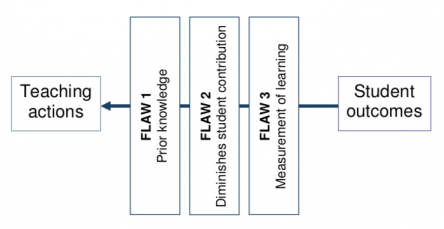The outcomes approach
“Teaching effectiveness is determined by student results.”
The following statements illustrate this view of teaching effectiveness:
- Teaching effectiveness is determined by what students achieve.
- The comparative effectiveness of teachers is best determined by comparing the achievements of the students they teach.
- The comparative effectiveness of teachers is best determined by comparing the added value they contribute to the achievements of the students they teach.
The first two statements have popular appeal, especially outside the teaching profession, and a simple logic: “Effective teachers cause students to learn. Thus high student achievement can be attributed to effective teaching; low achievement to ineffective teaching.”
The league tables of school pass rates in national examinations reflect such logic – the implication being that the best have the highest pass rates and by extension have the best teachers. A further extension of this logic is to suggest that teachers should be rewarded, through the mechanism of performance pay, for the successes of their students.
While there is no disputing the need to relate the assessment of teaching effectiveness to student learning and achievement this simple logic has three main flaws. These are illustrated in figure 2 and explained in the following text.
Figure 2: Teaching effectiveness and outcomes-based conception
The solid arrow in figure 2 represents the thinking behind the outcomes-based conception of teaching effectiveness, that is, student outcomes determine preferred teaching actions.
The three vertical boxes summarise the main flaws in this conception.
Flaw 1
Prior knowledge is a powerful determinant of current achievement. This makes it unfair to compare summative achievements of students and to attribute any difference to superior or inferior teaching.
Flaw 2
By linking achievement to teaching actions, the outcomes approach diminishes the role of the student as a source of success for their own achievement. A teacher’s ability to progress a student between time-points 1 and 2 is influenced by factors internal to the student. Factors include a student’s personal organisation, interest, motivation, personal attributions of success or failure, and beliefs about and motivations for particular subjects and tasks. While it is certainly true that a teacher can mitigate these influences, these factors cannot be simply dismissed as irrelevant to student progress and by extension to the assessment of teaching effectiveness.
Flaw 3
The measurement of student learning between time-points 1 and 2, if it is to be genuinely attributed to a teacher’s teaching, is extremely complex. The complexity arises because learning is not just influenced by teaching, and by factors internal to the student, but also by such factors as family background, ethnicity and social class. A genuine measure of a teacher’s contribution to learning would need to take account of these significant influences.
There are three related complications:
- The complexities of measurement may bias the assessment of teaching effectiveness towards more easily measured, objective, short-term outcomes.
- Even if more sophisticated measures were used there is no guarantee that the student’s learning could be attributed to the teacher. The student may well have received extra tutoring or support from external sources.
- Even if learning could be attributed it would lead into something of a “black box”. We would know that Teacher A had contributed substantially to the learning and achievement of the students but we would not know what, of the many things that Teacher A did, made the difference.
In summary, while the assessment of teaching effectiveness must attend to student outcomes and a teacher’s role in developing these, outcomes do not determine effectiveness.
Now to the third approach:
[link to Inquiry approach]

